I’ve always heard that the rainforest is not as dense within its boundaries as it is on the edges where vegetation receives more sunlight. We were able to witness this recently when we accompanied Dr. Terry Farrell (biology professor at Stetson University) and two graduate students, Sarah Smiley and Ethan Royal, as they thrust through the edges of a hammock on Lake Woodruff National Wildlife Refuge near DeLeon Springs, Florida, in search of pigmy rattlesnakes.
A hammock, I learned recently, is a group of trees surrounded by a marsh, and when water levels rise, the hammock may become flooded. Dr. Farrell pointed out water marks a foot or more up the tree trunks. “High water is actually nice because it pushes the snakes up,” he said.
[twocol_one]

[/twocol_one] [twocol_one_last]
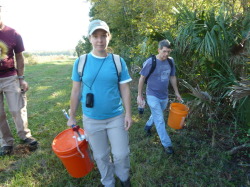
[/twocol_one_last]
Tight Coils
Because I am not a fan of spiders – and Florida supports some impressive species – I followed closely behind Dr. Farrell to avoid becoming tangled in webs. The others, including Chuck, spread out, snake hooks and collecting buckets in hand, inspecting fallen palm fronds and leaf clusters looking for telltale dark circles that indicated tightly coiled pigmy rattlesnakes.
“A lot of snakes have loose coils,” said Dr. Farrell. “Rattlesnakes have tight coils with no ground showing. The vast majority of snakes we find are in tight coils.”
[twocol_one]
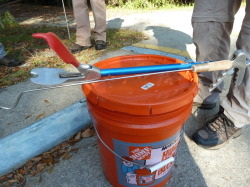
[/twocol_one] [twocol_one_last]

[/twocol_one_last]
Connecting with Dr. Farrell
We knew for some time that Dr. Farrell is well versed on and maintains an interest in the pigmy rattlesnake, and we had hoped to connect with him while we volunteered at Lake Woodruff NWR over the winter. According to Dr. Farrell’s biography on Stetson’s website, “After becoming a faculty member of Stetson in 1989, he spent much of the next two decades studying pigmy rattlesnakes and box turtles at Lake Woodruff National Wildlife Refuge with Peter May and a dedicated group of Stetson University students.”
Natural History Tidbits
As I followed Dr. Farrell through the hammock, he shared natural history tidbits of the area and answered my myriad questions, such as, “Is the interior of the hammock always this sparse or is it because of the prescribed burn?”
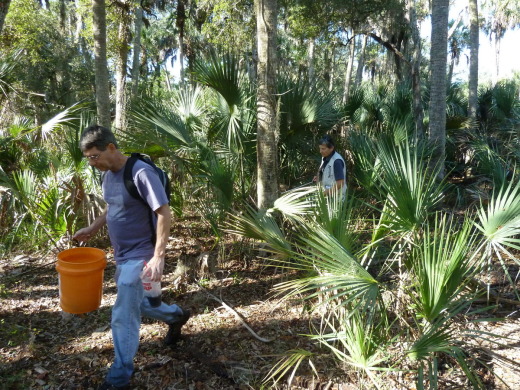
Vegetation in the hammock had regrown since the burn, but open areas allowed us to navigate fairly easily through the brush. “It’s probably less dense if they don’t burn,” said Dr. Farrell, “because the trees retain the nutrients.” Burning releases nutrients and makes them more available to other vegetation.
While searching for the pigmy rattlesnake, we encountered a box turtle that had previously been captured and marked for study. Dr. Farrell pointed to the holes drilled into the turtle’s scutes, placed strategically to identify the animal for future study. Farther on, as I stumbled over fallen tree branches and pushed aside palm fronds, I discovered the shell of a turtle, green with age that indicated it had died some time ago. This shell, however, had no holes drilled in it.
[twocol_one]
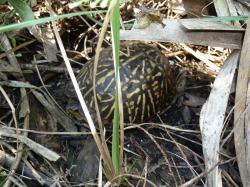
[/twocol_one] [twocol_one_last]
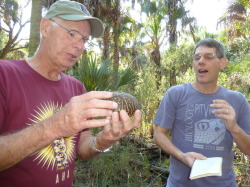
[/twocol_one_last]
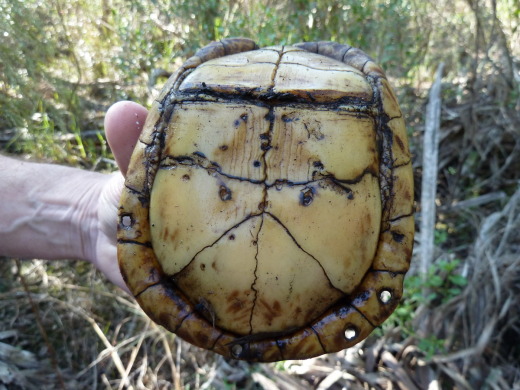
Dr. Farrell spotted and captured a tiny Leopard frog. “Perfect pigmy food,” he said, holding it toward us for our inspection. “That’s why there’s an abundance of pigmy rattlesnakes here because of abundance of frogs. There’s good frog diversity here.” Pigmys also eat ribbon snakes, centipedes, and an occasional bird.
[twocol_one]

[/twocol_one] [twocol_one_last]
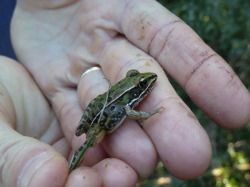
[/twocol_one_last]
Different Behaviors
Skirting poison ivy and slapping at mosquitoes, I continued following Dr. Farrell as he discussed the natural history of the pigmy rattlesnake. “They almost never strike if they’re poked when coiled,” he said, specifying that he dons thick gloves before that experiment. “But when you find them stretched out on the road, their behavior is different.”
His description of head jerking matched what I had witnessed when driving back from the Refuge a few days earlier. On the road in front of me, a stretched-out pigmy rattlesnake laid perfectly still while I snapped several pictures. But when it finally noticed my presence, its head jerked back and forth toward me in a threatening behavior before bolting for cover. It’s their attempt, according to Dr. Farrell, to say “I’m bad!”
“They’re not interested in contact,” said Dr. Farrell. “They’re ‘bluff striking’ just to show they can move fast.”
Locating Pigmy Rattlesnakes
The researchers expect to find a pigmy rattlesnake for every 1 ½ observer hours. Sarah is working on her doctorate studying how venom relates to predator/prey interactions. Ethan searched for snakes to video their reactions to a prey species.
Although pigmy rattlesnakes are plentiful in this area, our search failed to locate any. “We’ll be going out at other times,” said Dr. Farrell, “hopefully when the snakes are more cooperative. We’ll be in touch.”
We’ll look forward to it!

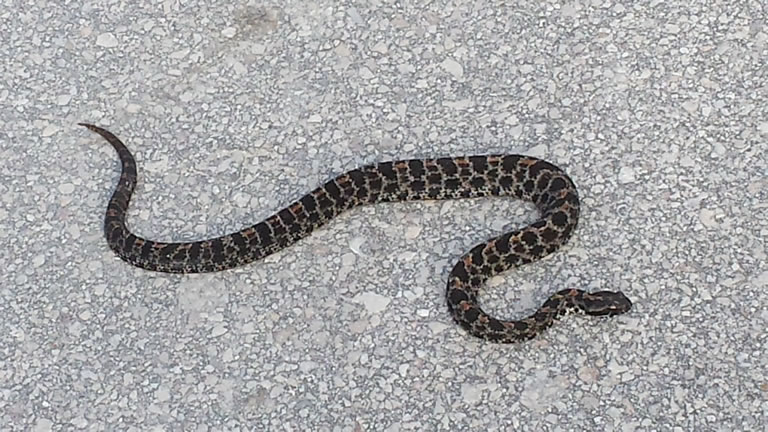
Thats AWESOME!! Some day I wish to do stuff like that. What you guys did, that’s what i dream of doing. Going out to find and do research on reptiles and amphibians. I’m so jealous of you guys now, I’m always trying to get out and do stuff like that in my free time but lately i haven’t had free time do to how involved i am at school and when i do have free time no one really wants to take me to do this stuff(mainly because they done much like reptiles and/or they just don’t feel like getting up to take me out). my dream is to move to either Florida, Australia because of the reptiles and amphibians! if I cant do that I at least want to do a research project in Australia or some where in Asia. I know its a big dream but whats the fun in dreaming small…thanks again Chuck and Betty for another wonderful and exciting story about your adventures!
Hi William,
Thanks for your great comments on our latest article! At this point in your life, you should focus on your education and set and do your best to meet goals. I sound like I’m preaching, but it was told to me when I was probably your age. Growing up, in Florida, I didn’t have a lot of support from my parents and driving-age friends either, so there was lots of bike riding to get to areas to explore. All of that was in a smaller town with lighter traffic than you most likely have where you live. But, sometimes you can explore on your own and benefit years later from that activity. I, too, wanted to move to Australia, but it’s probably better having stayed in the US. Australia does have an impressive array of venomous snakes and many other reptiles not seen in this part of the world, but as I get older, I still prefer the local “talent.” If you have the opportunity, try to take scientific courses when available in your school. Those courses may help guide you in a direction that is most interesting. Keep in mind that many, many research jobs are not high paying, but very satisfying. But, Dr Farrell started out with a passion, got an education and now is influencing students like you……and me as well! You never stop learning and you never know it all. Right now, school may not be the most thrilling event in your life, but it’s just like eating properly…..later on in life you’ll be glad you did it! I grew up not too far from where we are staying this winter, but still have to re-learn about so much of the wildlife in this area. It’s good to learn and hopefully we will be able to add more experiences to our blog. Stay tuned! And, keep your passion alive in whatever direction you want to go!